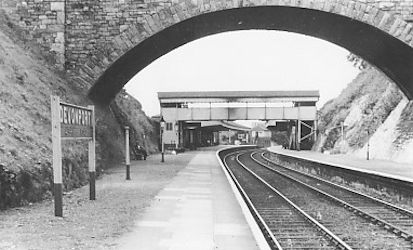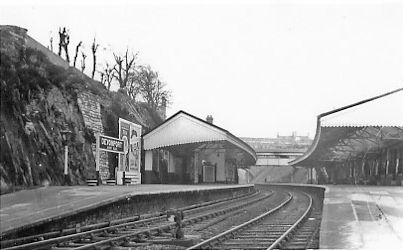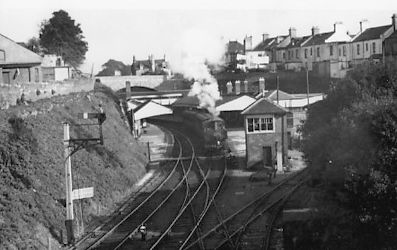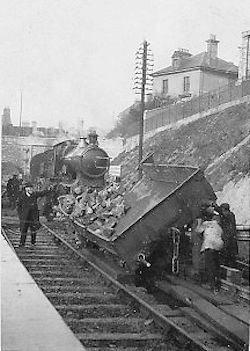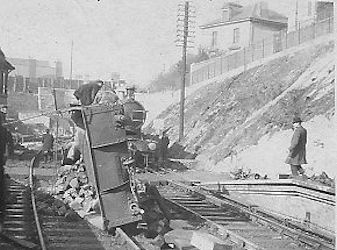|
OLD DEVONPORT
. UK |
||
|
© Brian
Moseley, Plymouth Webpage created: February 11, 2016 Webpage updated: January 21, 2022 |
||
|
RAILWAYS IN OLD DEVONPORT
| CORNWALL RAILWAY
COMPANY /
GREAT WESTERN
RAILWAY COMPANY DEVONPORT ALBERT ROAD STATION
Approaching Devonport Albert Road Station in
the Down direction towards Keyham Station. When opened by the Cornwall Railway Company on Wednesday May 4th 1859 this was known simply as Devonport Station. It was the only railway station in Devonport and the only stopping place on the Cornwall Railway between Plymouth Station at Millbay and Saltash Station. A timber-built goods shed was provided on the Down sided squashed between the Station and Devonport Tunnel. The line was initially only single track but between June and August 1860 the line was doubled between Plymouth Station (Millbay) and Devonport Station, as far as Devonport Tunnel. Up and Down signals were provided but they were evidently controlled by railway constables as there was no signal box. It is probable that the Up platform was not constructed until this time. Devonport Station Signal Box came into operation on Friday November 9th 1877 and was equipped with twenty levers. Both Devonport Station and Devonport Signal Box became the property of the Great Western Railway Company on and as from Monday July 1st 1889, when the Cornwall Railway Company was dissolved.
Devonport Albert Road Station looking
towards Gradually the Great Western Railway Company was doubling the track of its main line and the stretch from Devonport Tunnel to Keyham Viaduct was completed in October 1899 and a temporary signal box, Keyham Viaduct East Signal Box, opened at the Devonport end of the viaduct. The Devonport Station Signal Box was also replaced in 1899, the new one having 29 levers, albeit with 9 of them not used.
A Down railmotor to Saltash leaves Devonport
Albert Road Station. The squashed goods shed referred to above was inconvenient for rail traffic to access and in 1902 local contractor Mr A N Coles, of Plymouth, started work on building a new goods depot adjacent to Valletort Road. The new depot was some distance from the Station and to reach it two lines had to be laid from the Plymouth end of Devonport Station and carried through a cutting in Valletort Road and under an iron bridge. The site of the shed was some 60 feet deep and had to be filled with some 50,000 cubic yards of rubble to make it level. More convenient approach roads were made to the depot and the whole project was viewed as a vast improvement that served the needs of the Mercantile Association of the Town. The cost of the work was about £20,000, exclusive of permanent way. According to the Great Western Railway Company's official "Traffic Dealt with at Stations and Depots", published circa 1936, in the calendar year 1903 Devonport Station issued 109,507 railway tickets, dealt with 1,961 parcels and took in passenger income £17,215. The goods depot collected £23,523. In 1904, the Company once again contracted with Mr Coles to carry out improvement works at the Station. Pedestrian access to the Up platform, for London, was by using the Down platform and across a footbridge at the Penzance end of the Station. For the benefit of people from Morice Town and Keyham, a path some 700 feet long was cut into the embankment from Albert Road to the Up platform. The old footbridge was closed and replaced with a temporary one. The path was also extended to Havelock Terrace for the benefit of passengers living in that area. A new steel footbridge, with a roof, was erected at the Plymouth end of the Station and the temporary one was removed on Saturday December 31st 1904. Additional flights of steps were in the process of being installed to link with the paths with the platforms. The platform on the Down side was lengthened by 150 feet and widened by 10 feet, which meant that the old offices had to be demolished and new ones erected further back. This enabled the larger waiting-rooms, booking office, parcels office and cloakrooms to be built. The UP platform was also extended by 150 feet but the original buildings were all retained. The old lavatory was transformed into a booking office and the old store at the other end of the block became the lavatory. The wooden verandas, which only extended the length of the buildings on each platform, and were very narrow, were replaced with much longer and broader ones supported on steel cantilevers and covered with iron and glass. At the same time new sidings were laid in to the horse and carriage landings near the old goods shed. The sidings were known as Up sidings although they were on the Down side of the track because they could only be accessed from the Up line. Milk traffic was handled here. This improvement work was expected to cost around £10,000 and the painting and finishing work was expected to be completed in January 1905. The contactor's foreman of works for the project was Mr J Bonney. An Up passenger train of eight carriages and a goods train were in collision at Devonport Station on Tuesday February 28th 1905. The Up goods train of 19 wagons and a brake van, hauled by locomotive number 1897, had arrived at Devonport Station and was to be shunted on to the Down line in order to let a passenger train pass. All except the engine and the front two wagons, loaded with stone, had passed over the points to the Down tracks when the 7.10am train from Falmouth, headed by GWR 4-4-0 locomotive number 3468 "Calcutta," came through the tunnel on the Up line and collided with the second of the two wagons, knocking the body off its wheels. The driver, whose name was stated as Mr Hammadd, who has not been traced, fractured his right arm but the stoker was unhurt. The driver of the goods train, Mr Alfred Baker, of 2 Sydney Street, Plymouth, sustained a compound fracture of the right arm and was conveyed to the Royal Albert Hospital at Devonport, where he was attended by Doctor F E Row. Although several passengers were knocked about and one gentleman was thrown out of his eat across into the passenger sat opposite, there was apparently no panic. One passenger told the reporter from the Western Morning News that: 'Oh, yes, we knew it was a collision but most of us treated it more as a joke than anything else'.
The scene at the accident on February 28th
1905. The station master, Mr Martin, immediately contacted his opposite number at Keyham Station and Plymouth Station and all trains were stopped. Divisional Superintendent Mr Grant, Inspector Scantlebury and Messrs Dawson, Giles, Quigley, Sleeman and Wright, quickly arrived at the Station with a breakdown train. The passengers, which included 32 ladies and gentlemen from a theatrical touring company in a reserved carriage, detrained and walked the short distance to the Station, where Doctor G A Rae attended to them if required. The accident happened at just before 10am and by 11.30am the Up line had been completely cleared by the breakdown crew and the slightly damaged "Calcurra" took its train into Plymouth Station. The Down was blocked by the goods train, which was mostly in the Devonport Tunnel. Pilot working was then introduced between Keyham Station and presumably Devonport Junction Signal Box. Down trains thus proceeded over the Up line until Keyham. It was noted that at 12.40pm a long, double-headed passenger train passed on its way to Cornwall.
Another view of the scene of the accident. It seems that what happened was that the Devonport Signalman had accepted the Up train from Keyham even thought the goods train was in the process of changing tracks. The Devonport Up Home signal was on the Station side of Devonport Tunnel and thus not clearly visible until coming out of the Tunnel. The position of the Up Distant signal would have warned the passenger train driver that he was going to have to stop and he stated that his train was traveling at about 4mph as he emerged from the Tunnel and found the Home signal against him. He applied the brakes but the track was slippery and the engine slid into the wagons. Full traffic was resumed at 1pm. According to the Great Western Railway Company's official "Traffic Dealt with at Stations and Depots", published circa 1936, in the calendar year 1913 Devonport Station, which included Dockyard Halt and Ford Halt, issued 302,816 railway tickets, dealt with 2,152 parcels and took in passenger income £23,714. The goods depot collected £42,754. During the calendar year 1923 Devonport Station, which included Dockyard Halt and Ford Halt, issued 205,475 railway tickets plus a further 1,141 season tickets, dealt with 1,711 parcels and took in passenger income of £31,242. The goods depot collected £70,594 during the same period. At 4am in the early hours of Friday March 25th 1927 the Guard of a goods train fell between his train and the platform while attempting to mount the footboard of his Guard's Van. 62-years-old Mr Thomas Davis, of Northumberland Terrace, West Hoe, Plymouth, was dragged to the end of the platform before the train was stopped and was badly injured. Luckily he did not come into contact with the wheels of the train. Mr Davis was swiftly taken to Plymouth Station at Millbay, where the Saint John Ambulance Brigade were present to take him to the nearby Devon and Cornwall Homoeopathic Hospital in Lockyer Street. On and as from Monday April 1st 1929 the Great Western Railway Company took over the former Royal Mail Parcels' Office in the North Road Plymouth Station forecourt and established the Railway's own central Parcel's Office. It would appear that from that date parcels were no longer accepted at or delivered from Devonport Station. However, this is contradicted by the statement immediately below. According to the Great Western Railway Company's official "Traffic Dealt with at Stations and Depots", published circa 1936, in the calendar year 1929 Devonport Station, which included Dockyard Halt and Ford Halt, issued 145,054 railway tickets, dealt with 1,545 parcels and took in passenger income £20,040. The goods depot collected £63,964. According to the "The Official Hand-book of Stations 1938" Devonport Station dealt with goods traffic, passengers, parcels, miscellaneous traffic, furniture vans, carriages, motor cars, portable engines and machines on wheels, live stock, horse boxes, prize cattle vans, and carriages and motor cars by passenger or parcels trains. It was equipped with a crane capable of lifting 15 tons. When the railway network was nationalized on Thursday January 1st 1948 the Station name was altered to Devonport Albert Road Station to distinguish it from the former Southern Railway Company one, Devonport King's Road Station. "The Official Hand-book of Stations 1956" repeated the list of facilities as in 1938. By the end of the Second World War the milk traffic had ceased and the Up Sidings were removed in 1957. The goods depot at Valletort Road was closed from Monday April 15th 1957 and the site turned over to the British Railways Civil Engineering Department. The track into and within the depot was removed in September 1970. On Weekdays and Sundays, 'where train service permits', commencing on May 1st 1953, the following cheap day return tickets, first and third class, were available from Devonport Albert Road Station to: Bickleigh, 3 shillings 1st, 2 shillings 3rd; Bittaford Platform, 5 shillings (s) 3 pence (d) 1st, 3s 6d 3rd; Bodmin General, 10s 1st class, 6s 9d 3rd class; Bodmin Road, 8s 9d 1st, 5s 9d, 3rd; Brent, 6s 1st, 4s 3rd; Clearbrook Halt, 3s 9d 1st, 2s 6d, 3rd; Cornwood, 3s 6d 1st, 2s 3d 3rd; Doublebois, 6s 9d 1st, 4s 6d 3rd; Horrabridge, 4s 9d 1st, 3s 3d 3rd; Ivybridge, 4s 6d 1st, 3s 3rd; Kingsbridge, 10s 1st, 6s 9d 3rd; Liskeard, 5s 9d 1st, 3s 9d 3rd; Looe, 8s 9d 1st, 5s 9d 3rd; Lostwithiel, 10s 1st, 6s 9d 3rd; Lydford, 8s 1st, 5s 3d 3rd; Mary Tavy, 7s 1st 4s 9d 3rd; Menheniot, 4s 9d 1st, 3s 3d 3rd; Plym Bridge Platform, 2s 3d 1st, 1s 5d 3rd; Princetown, 7s 9d 1st, 5s 3d 3rd; Saint Germans, 3s 1st, 2s 3rd; Shaugh Bridge Platform, 3s 6d 1st, 2s 3d 3rd; Tavistock South, 5s 3d 1st, 3s 6d, 3rd; Totnes, 8s 3d 1st, 5s 6d 3rd; Whitchurch Down Platform, 5s 3d 1st, 3s 6d 3rd; Wranagton, 5s 3d 1st, 3s 6d 3rd; and Yelverton, 4s 1st, 2s 9d 3rd. The tickets to Tavistock South Station and Lydford Station were available for return from Tavistock North Station or Lydford (Southern) Station. Devonport Station Signal Box closed on Saturday November 26th 1960 when the new Plymouth Multiple Aspect Signalling System came into operation from the Plymouth Panel Box. With the commencement of the new time table on Monday May 6th 1968 the Station was once again renamed as simply "Devonport". It became an unstaffed stopping place on and as from May 19th 1969. Devonport Station remains in use by the trains of the modern Great Western Railway Company but is completely devoid of any buildings other than the modern bus-stop type shelters.
|
||
